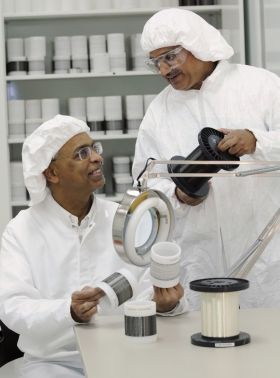Researchers at the Georgia Institute of Technology have developed a breakthrough method to enhance strength and modulus of carbon fibers. This new technique is based on an advanced method for spinning an organic polymer resin known as polyacrylonitrile (PAN), which is used to create carbon fibers.
 Professor Satish Kumar research engineer M.G. Kamath examine the precursor and carbon fibers processed at Georgia Tech. (Credit: Gary Meek)
Professor Satish Kumar research engineer M.G. Kamath examine the precursor and carbon fibers processed at Georgia Tech. (Credit: Gary Meek)
Carbon fibers are light in weight, but have high strength, when compared to steel. Composite materials made from carbon-fiber-reinforced polymers find use in numerous applications, including automotive and aerospace. Huge sections of the Boeing 787 aircraft are built using these materials. Carbon-fiber technology is believed by many to possess the capability to manufacture composites that are 10 times stronger than those manufactured today.
This research is part of a DARPA-sponsored $9.8 million project. Improving the strength of carbon-fiber materials is the core objective of this four-year project.
Kumar illustrated that tensile modulus, which is a measure of stiffness, can be defined as the force required for stretching a material by a given amount, whereas tensile strength refers to the amount of force required to cause the material to break down.
To perform gel spinning, the first step requires the solution to be converted into a gel. This method enables polymer chains to be fastened together, and generates strong inter-chain forces that boost tensile strength. Moreover, directional orientation of fibers is also increased by gel spinning, which, in turn, further enhances strength.
By using a gel-spinning technique to process polyacrylonitrile copolymer into carbon fibers, we have developed next-generation carbon fibers that exhibit a combination of strength and modulus not seen previously with the conventional solution-spun method. In addition, our work shows that the gel-spinning approach provides a pathway for even greater improvements.
Satish Kumar, a professor in the Georgia Tech School of Materials Science and Engineering
Conversely, the traditional solution spinning method, which was formulated over six decades ago, involves direct transformation of a PAN co-polymer solution into a solid fiber without the transitional gel phase, thus yielding a low-strength material.
The gel-spun carbon fiber developed by Georgia Institute of Technology team was tested at a measure of ultimate tensile strength, which is about 5.5 to 5.8GPa. The material was found to possess a tensile modulus in the range of 354-375GPa. A continuous carbonization line at Georgia Institute of Technology was used to produce this material. The line was built as part of this DARPA project.
This is the highest combination of strength and modulus for any continuous fiber reported to-date. At short gauge length, fiber tensile strength was measured as high as 12.1GPa, which is the highest tensile-strength value ever reported for a PAN-based carbon fiber.
Satish Kumar, a professor in the Georgia Tech School of Materials Science and Engineering
Kumar highlighted that when the gel-spun carbon fiber’s internal structure was measured at the nanoscale, it displayed lesser imperfections than advanced commercial carbon fibers, such as IM7. An exceptional feature of the gel-spun fiber is that it showed a lesser degree of polymer-chain entanglements compared to those manufactured using the solution spinning method.
Using a selective treatment process called pyrolysis, Kumar’s team converted the gel-spun polymer mix into carbon fibers. The process requires the spun polymer to be slowly subjected to heating as well as stretching. This process removes large amounts of oxygen, hydrogen and nitrogen from the polymer, and leaves mainly strength-increasing carbon.
It’s important to remember that the current performance of solution-spun PAN-based carbon fibers has been achieved after many years of material and process optimization – yet very limited material and process optimization studies have been carried out to date on the gel-spun PAN fiber. In the future, we believe that materials and process optimization, enhanced fiber circularity, and increased solution homogeneity will further increase the strength and modulus of the gel-spinning method.
Satish Kumar, a professor in the Georgia Tech School of Materials Science and Engineering
The study results have been reported in the journal, Carbon.
References